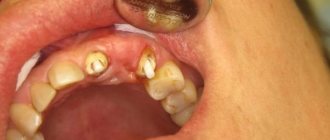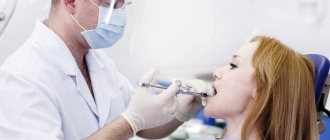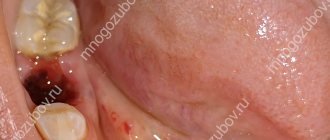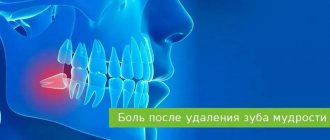Anesthesia during tooth extraction helps eliminate pain and normalize the patient’s psychological state. The variability of techniques makes it possible to select the optimal type of pain relief, taking into account the age, duration and traumatic nature of treatment, and the physical and mental state of the patient. When removing teeth, surface, infiltration and conduction anesthesia is used, and general anesthesia is used if indicated.
Content:
- Options for local anesthesia of a diseased tooth 1.1. Application 1.2. Infiltration 1.3. Conductor 1.4. Intraosseous 1.5. Intraligamentary
- Contraindications
- Pros and cons of local anesthesia in dentistry
To ensure that tooth extraction takes place with maximum comfort for the patient and is not associated with pain, dentists use special painkillers.
If the case is very complex and local anesthetics do not cope, anesthesia is used. Painkillers used in dentistry block the transmission of nerve impulses from the torn unit to the brain. Due to this, all manipulations carried out by a specialist are calmly perceived by a person.
When do you need to see a dentist urgently?
- Severe, acute, throbbing pain that is not relieved by an analgesic, spreads across the face, radiates to the ear, neck;
- bleeding from the socket that does not stop, but rather intensifies;
- absence of a blood clot in the socket;
- bad breath;
- discharge of pus from the wound;
- the formation of yellow, dirty gray, green plaque on the wound;
- temperature rise above 38℃;
- numbness of a part of the face (gums, cheeks) for more than a day;
- pronounced swelling of the gums and cheeks, which does not decrease 2-3 days after extraction.
Options for local anesthesia of a sore tooth
Local anesthesia can be conditionally classified into the following groups:
- application;
- infiltration;
- conductor;
- intraosseous;
- intraligamentary.
Let's look at each in more detail.
Appliqué
This type of anesthesia for tooth extraction can only be used if a simple treatment is planned or if the gum area where the anesthetic will be injected needs to be made insensitive. More often, the application technique is used when providing dental care to young children. Baby teeth do not have branched roots and, when they are already thoroughly loosened, before pulling them out, it is quite possible to limit yourself to applying a local anesthetic. The latter usually contains lidocaine or benzocaine.
Infiltration
A very common option for pain relief. Involves injecting the medication directly into the gums. As a result, the treated area, part of the cheek, lip and tongue become numb.
The technique is suitable if the therapy is simple and takes little time, for example, when pulling out baby teeth. It is offered to adults if the unit is already highly mobile and can be easily grasped with forceps.
Anesthesia wears off after tooth extraction within three to four hours. Then the usual sensitivity gradually returns.
Conductor
A more serious option for pain relief. It is used if several teeth need to be removed at once. This is possible if preparation for prosthetics is underway. The doctor makes an injection into the gum and injects an anesthetic. But the needle is installed in such a way that after the injection, not only individual nerve impulses are blocked, but the peripheral branches of the nerve. Due to this, a large area is covered.
Taking into account exactly where the medicine is injected and which tooth is to be removed, conduction anesthesia is divided into:
- Mental. Suitable if you need to pull out canines, incisors, premolars.
- Tuberal. Only used when working with molars.
- Thorusal. It is used if several lower units located in different zones are to be pulled out.
To select the most appropriate anesthesia option for tooth extraction, the doctor examines the oral cavity. In rare cases, the injection is given extraorally. Then the needle is inserted into the gum tissue directly through the cheek.
Intraosseous
With this type of anesthesia, an injection is made directly into the bone tissue. Using a long needle, they reach the bone plate that forms the frame for the tooth. As a result, the surrounding soft tissues remain sensitive and do not go numb.
The intraosseous technique is indicated if it is necessary to remove unerupted and incorrectly located units of the oral cavity. Sometimes it is used when operating on the lower jaw, since it is easier to perform such technically complex anesthesia.
It is important to understand that intraosseous anesthesia renders only the treated tooth numb. If its roots go very deep or intertwine with neighboring ones, it makes sense to use another option for pain relief.
Intraligamentary
The anesthetic is injected directly into the tissue, and not into the nerve, that is, the work is carried out exclusively with the periodontal space. The injection is given under great pressure, but it causes almost no pain.
The intraligamentary technique is optimal if it is necessary to remove premolars, molars, incisors and canines in a child. Sensitivity is lost almost immediately.
Within a minute after the injection, the unit becomes “frozen.” The freezing effect lasts for about 20 minutes. This is quite enough to perform a simple surgical operation.
Types of anesthesia for tooth extraction and methods of its behavior
Based on the depth of anesthesia, anesthesia is divided into the following types:
- surface;
- easy;
- full;
- super deep.
For dental treatment under anesthesia, only superficial and light anesthesia is used in dentistry. While the last two types are used for complex operations, for example, for maxillofacial injuries.
Anesthesia is carried out in two main ways:
- inhalation - you inhale sprayed particles of the drug through a special mask;
- intravenously - using a regular injection.
High-quality anesthetic drugs promote restful drug-induced sleep and recovery from it without any complications. Modern anesthetic medications are highly safe and suitable even for patients with allergies. They do not cause side effects or addiction and are easily eliminated from the body.
Contraindications
Sometimes doctors cannot use anesthetics when extracting teeth. This is due to the contraindications of the drugs themselves and the individual characteristics of the patient’s body.
Among the most common contraindications:
- severe diseases of the cardiovascular system (stroke, myocardial infarction, after which less than six months have passed);
- allergy to compounds included in the painkiller.
If a patient has an endocrine disease that occurs in a decompensated form, he needs to go to the hospital for removal.
It is important to know . To avoid complications after using anesthesia, you need to inform the dental surgeon in advance about all existing chronic diseases, allergies, and medications used.
Home care
After surgery, you can take antiseptic baths on the first day. To do this, you can use furatsilin, chlorhexidine 0.05% or another antiseptic as prescribed by a doctor.
On the second day, you can already brush your teeth using a soft brush. Be careful not to touch the tooth socket, which should still contain a blood clot. After cleaning, you need to rinse the brush in an antiseptic and place it in a sterile place. On the same day, you can take warm baths based on sea salt. To do this, you need to dilute half a tsp. salt in 250-300 ml of water and add 0.25 tsp. soda
Sometimes doctors recommend baths with decoctions for healing. This can be oak bark, elecampane, sage, St. John's wort, chamomile and other plants.
Pros and cons of local anesthesia in dentistry
Among the advantages of local anesthesia:
- affordable price;
- lack of significant impact on the patient’s body;
- low risk of adverse reactions;
- the ability to treat and remove baby and molars without pain.
The disadvantages include:
- the possibility of developing allergies, including anaphylactic reactions, laryngeal edema;
- low effectiveness if there is a pronounced inflammatory process in the maxillofacial area.
If the anesthesia method is chosen correctly, the removal will take place quickly and without complications. Trust your health to experienced dentists. Then even the most complex dental problems will be solved quickly and without pain.
Stages of socket healing
- 2-3 hours
after
a blood clot (thrombus) forms
in the socket . It serves as a barrier to pathogenic microorganisms, preventing them from entering the wound. - The next 2-3 days
- the blood clot thickens, shrinks, the wound
becomes covered with a whitish coating
(fibrin film), the formation of granulation tissue begins inside the hole, the basis for the restoration of mucous membranes. - After 3-7 days
, the thrombus lightens, becomes whitish, the connective tissue has practically filled the hole, swelling and pain are minimal or completely absent. - After 7-10 days
, the hole has shrunk significantly,
new bone begins to form
, which will completely fill the defect after 4-6 months. - After 2 weeks
,
the gums have completely healed
.
What is prohibited?
- To prevent accidental washing of a blood clot from the socket, it is forbidden to rinse your mouth. To treat the cavity, oral baths are quite sufficient;
- Hot compresses are prohibited, this stimulates severe swelling, the development of inflammation, and bleeding;
- You cannot puff out your cheeks, blow your nose too much, or sneeze;
- It is forbidden to touch the wound with your fingers, tongue, or objects;
- You can’t eat hot, cold, irritating foods; preference is for soft, warm, neutral foods;
- you cannot smoke or drink alcohol for at least a week - tobacco and alcohol slow down tissue regeneration;
- Hypothermia and overheating must be avoided - going to the sauna, swimming pool, solarium is prohibited for 5-7 days;
- Do not take aspirin or other blood thinners;
- do not engage in active sports, do not subject the body to excessive physical or sports stress.
When can you eat and drink after surgery?
You should not strictly limit yourself in nutrition, you will need strength to recover - you can eat as soon as the anesthesia wears off, namely after 2-3 hours. You can drink it immediately after you remove the cotton swab. Until this point, it is undesirable for food particles or bacteria to get into the open hole.
In the first 3-5 days, you need to take into account several nuances in nutrition so that further healing of the wound goes well:
- food should be warm. Hot or cold food will irritate tissues and cause blood vessels to dilate or constrict, which can cause new bleeding,
- It is better to exclude rough food to avoid mechanical damage to the wound. Soups, purees, baked and boiled foods, minced meat dishes,
- Do not chew food on the side where the tooth was removed to keep the protective clot intact.
Carefully! Many people mistakenly believe that in the first days it is better to drink and eat liquid foods through a straw. But in fact, suction creates a vacuum in the mouth, which can displace the clot or disrupt its integrity. Should not be doing that. For the same reason, you should not spit or suck in your cheeks.
We remove a wisdom tooth that is not growing properly
The rudiment, compared to other teeth, grows later than all others, so there is not enough space for its growth and the arrangement of neighboring teeth changes, they begin to bend.
In any case, a crooked molar can cause injury to soft tissues, which causes blood and wounds on the gums. If pieces of food remain after eating food, there is a risk of infection.
The worst thing is dystopia, since food not only gets into the soft tissues, but also remains in the interdental space. In this case, the teeth are destroyed as the process of decay begins.
Where is a person's wisdom tooth located?
Many people know that this tooth is also called a rudiment, figure eight or 3rd molar.
The name “eight” speaks for itself, since this tooth completes the dentition and is the eighth in a row. There is virtually no benefit to these teeth; they are considered ordinary molars. Formation occurs before the age of 8 and only at the age of 20 do they begin to emerge. The name wisdom teeth was invented back in the old days, because their eruption is equated to the age of maturity in physical and mental terms.
As a rule, the eruption of wisdom teeth is accompanied by pain and discomfort, and in some cases, abnormalities. The latter require surgical intervention.











